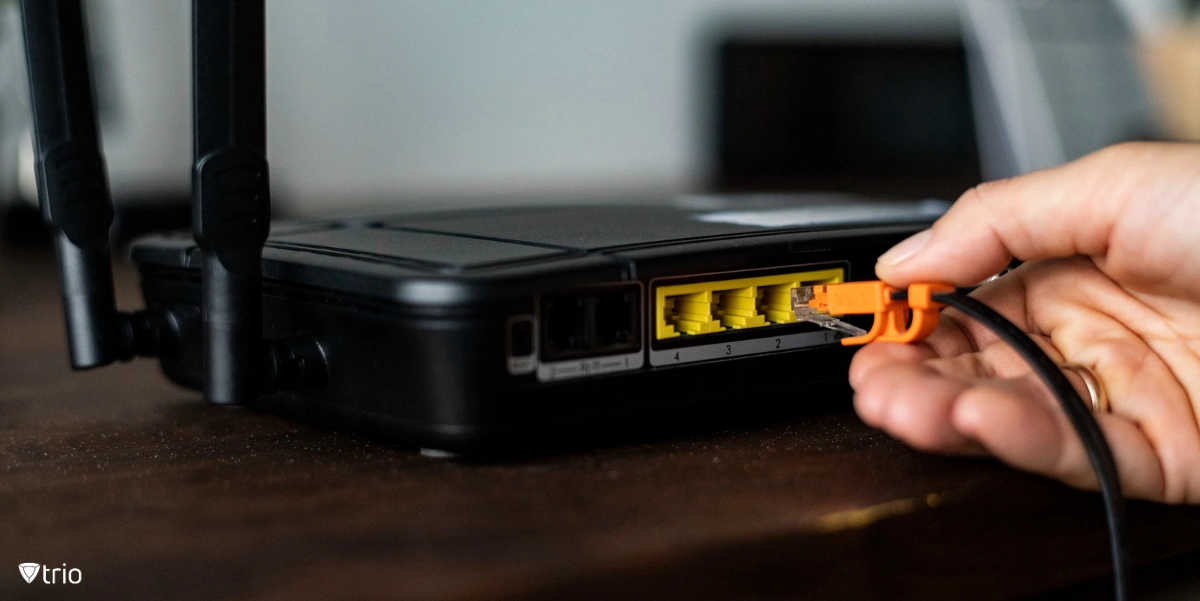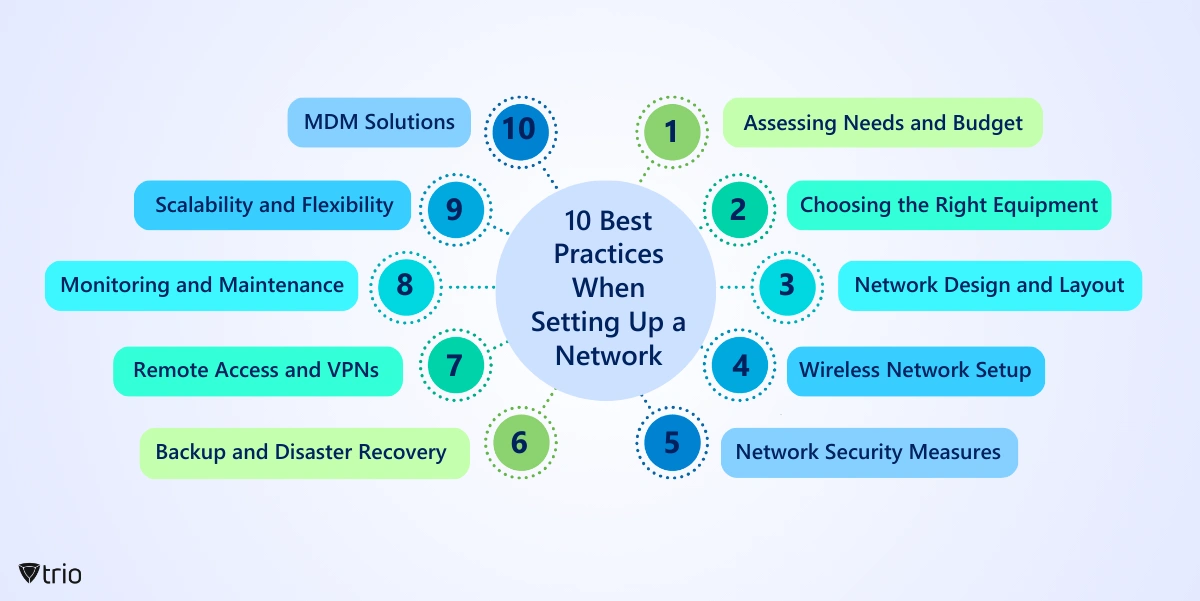In today’s digitally connected world, establishing a reliable and secure network infrastructure is essential for the success of small businesses. From facilitating day-to-day operations to safeguarding sensitive data, a well-designed network plays a pivotal role in driving efficiency, productivity, and competitiveness. However, creating a small business network setup can be a daunting task, especially for businesses with limited resources and expertise. In this blog post, we’ll explore the best practices for small business network setup, covering everything from assessing needs and budget to implementing robust security measures to ensure a solid foundation for your business’s network infrastructure.
-
Assessing Needs and Budget
Before embarking on setting up a small office network setup, it’s imperative to conduct a thorough assessment of its needs and budget. Consider factors such as the number of employees requiring network access, the types of devices they will use (e.g., desktops, laptops, smartphones), the bandwidth requirements for day-to-day operations, and any specialized software or services that may require network connectivity.
Additionally, carefully evaluate the available budget, taking into account not only the initial setup costs but also ongoing maintenance, upgrades, and potential expansion of your small business computer network. By understanding these requirements and constraints upfront, businesses can make informed decisions when selecting networking equipment and designing the network architecture.
-
Choosing the Right Equipment
Selecting the appropriate networking equipment lays the foundation for a robust and reliable computer network for small business. Routers serve as the gateway between the local network and the internet, so choosing a router capable of handling the anticipated traffic volume and providing essential security features is paramount. Switches facilitate communication between devices within the local network, and businesses should opt for managed switches that offer greater control over network traffic and security settings.
Access points enable wireless connectivity, and it’s essential to choose access points that support the latest Wi-Fi standards and offer features like guest networks and seamless roaming. Additionally, investing in a reliable firewall appliance provides essential protection against external threats by filtering incoming and outgoing network traffic based on predefined security rules. By investing in quality networking equipment that aligns with the business’s needs and budget, businesses can build a solid foundation for their network infrastructure.

-
Network Design and Layout
Before small business network installation, careful planning of the network design and layout is crucial for optimizing performance and security. Small business network design should consider factors such as the physical layout of their office space, the placement of networking equipment to minimize interference and maximize coverage, and the segmentation of the network to isolate sensitive data or devices. You can check out small business network design examples to get inspiration. Implementing VLANs (Virtual Local Area Networks) can help separate different types of traffic and enhance network security. Additionally, businesses should document the network topology to aid in troubleshooting and future expansion.
-
Wireless Network Setup
When setting up a wireless network, security should be a top priority. Businesses should enable strong encryption protocols such as WPA3 to protect against unauthorized access. Guest networks should be configured to provide internet access to visitors while keeping them isolated from the internal network.
Regularly updating firmware on access points and using features like wireless intrusion detection/prevention systems can help mitigate security risks. Additionally, businesses should perform regular site surveys to optimize wireless coverage and address any interference issues.
-
Network Security Measures
Implementing robust security measures after setting up a small business network is essential for protecting the network from cyber threats. Businesses should deploy firewalls to monitor and control incoming and outgoing traffic, as well as intrusion detection/prevention systems to detect and respond to suspicious activity.
Regularly updating software and firmware on networking equipment helps patch known vulnerabilities and strengthen defenses against emerging threats. Employee education and awareness training on security best practices can also help mitigate the risk of social engineering attacks and human error.

-
Backup and Disaster Recovery
Establishing a comprehensive backup and disaster recovery plan is essential for safeguarding critical data and ensuring business continuity. Businesses should regularly back up important data to both on-site and off-site locations to protect against hardware failures, natural disasters, and cyber-attacks.
Testing backup procedures regularly helps ensure that data can be recovered quickly and accurately in the event of an emergency. Additionally, businesses should consider implementing redundant systems and failover mechanisms to minimize downtime and maintain operations during a crisis.
-
Remote Access and VPNs
Providing secure remote access to the network is essential for enabling employees to work remotely while maintaining data security. Businesses should set up Virtual Private Networks (VPNs) to encrypt communication between remote devices and the internal network, preventing unauthorized access and eavesdropping.
Multi-factor authentication should be implemented to add an extra layer of security to remote access. Regularly updating VPN software and monitoring for any signs of unauthorized access helps ensure the integrity of remote connections.
-
Monitoring and Maintenance
Regular monitoring and maintenance are critical for keeping the network running smoothly and identifying potential issues before they escalate. Businesses should use network monitoring tools to track performance metrics, detect anomalies, and troubleshoot problems proactively.
Routine maintenance tasks such as updating software and firmware, checking hardware health, and reviewing access controls should be performed regularly to ensure the security and stability of the network.
-
Scalability and Flexibility
Designing the network with scalability and flexibility in mind is essential for accommodating future growth and technological advancements. Businesses should choose networking equipment and architectures that can easily scale to support increased bandwidth requirements, additional devices, and new applications. Using small business network setup guides is great but it’s important that they keep your organization’s scalability in mind.
Implementing modular and standards-based solutions allows for seamless integration of new technologies and upgrades without disrupting existing operations. Regularly reassessing network requirements and conducting periodic capacity planning exercises help ensure that the network can adapt to evolving business needs.
-
Mobile Device Management (MDM)
With the proliferation of mobile devices in the workplace, implementing Mobile Device Management (MDM) solutions is crucial for maintaining security and control over these devices. MDM software allows businesses to remotely manage and enforce policies on smartphones, tablets, and other mobile devices used by employees. Our recommendation is to use Trio, the ultimate MDM solution.
Through Trio, businesses can enforce security policies such as device encryption, password requirements, and remote data wipes in case of loss or theft. Additionally, Trio enables businesses to distribute and manage business applications, ensuring that employees have access to the tools they need while maintaining control over corporate data. By beginning to use Trio’s free demo, businesses can mitigate the security risks associated with mobile devices and enhance overall network security.

See Trio in Action: Get Your Free Trial Now!
Conclusion
Building a resilient network infrastructure is not just about connecting devices—it’s about laying the groundwork for growth, innovation, and success. By following the best practices outlined in this blog post, small businesses can create a network that not only meets their current needs but also adapts to future challenges and opportunities. From choosing the right equipment to implementing stringent security measures and embracing emerging technologies like Mobile Device Management, investing in a well-designed network is an investment in the future of your business. With careful planning, proactive maintenance, and a commitment to continuous improvement, small businesses can build a network that powers their growth and enables them to thrive in today’s competitive landscape.




